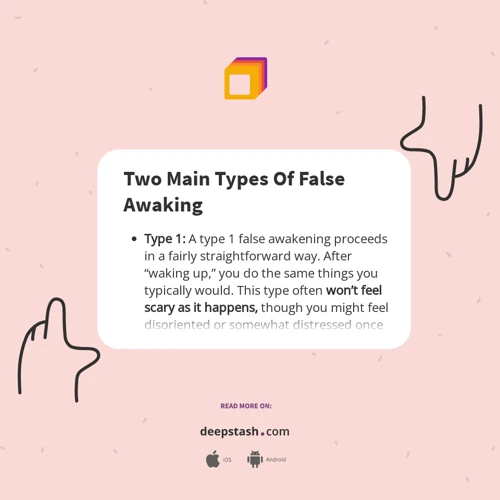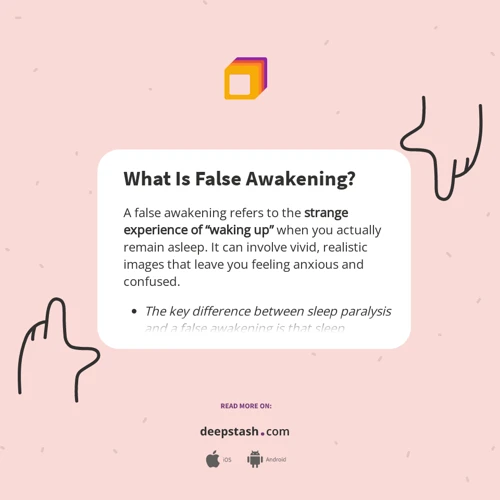Welcome to the puzzling world of False Awakening Dreams! Have you ever woken up from a dream, only to find yourself still trapped within the world of slumber? This phenomenon, known as a false awakening, can leave you feeling disoriented and questioning reality. In this article, we will dive deep into the causes and interpretations of these elusive dreams, shedding light on the possible meanings hidden within their perplexing scenarios. Whether you’re curious about the psychological factors at play or seeking ways to navigate and manage these dreams, we’ve got you covered. So, grab a cup of coffee (just in case you’re still dreaming) and get ready to unravel the mysteries of false awakening dreams.
What are False Awakening Dreams?

False Awakening Dreams, also known as recurring or simulated awakenings, are a fascinating phenomenon within the realm of dreaming. These dreams create a deceptive illusion of waking up, leading individuals to believe that they have already risen from sleep, only to discover that they are still immersed in a dream state. The characteristics of false awakening dreams can vary, but they often involve mundane and familiar scenarios, such as waking up in one’s own bed or going through typical morning routines. What sets these dreams apart is the uncanny feeling of realism, causing individuals to question the boundaries between dreams and reality. The line becomes blurred, leaving one perplexed and uncertain about the true state of wakefulness. To learn more about the differences between lucid dreaming and false awakening dreams, you can explore our previous article here. The science behind false awakening dreams remains a mystery, but researchers continue to study this phenomenon, hoping to uncover more insights into the intricate world of dreaming. If you’re curious about the scientific perspective, check out our article here.
Definition and Characteristics
A false awakening dream can be defined as a dream within a dream, where the dreamer mistakenly believes they have woken up from sleep, only to realize later that they are still in a dream state. The characteristics of these dreams can vary greatly, but there are some common elements that distinguish them. Firstly, false awakening dreams often mimic reality in great detail, creating an incredibly convincing simulation of waking life. The environment and setting are usually familiar, with the dreamer finding themselves in their own bed or home. This level of realism can make it difficult to recognize the dream for what it truly is. Additionally, false awakening dreams tend to involve mundane and routine activities, such as getting ready for the day or performing everyday tasks. These dreams can feel so ordinary and authentic that it becomes challenging to discern between the dream world and reality. To further explore the intricacies of false awakening dreams, you can read our article on Exploring False Awakening Dreams.
Common Scenarios
Common scenarios in false awakening dreams can vary greatly, but there are some recurring themes that many individuals experience. One common scenario involves waking up in one’s own bedroom, believing that the dreamer is starting their day. They may go about their usual morning routine, such as getting out of bed, brushing their teeth, or checking their phone, only to suddenly realize that they are still dreaming. Another common scenario is waking up in a different location, like a hotel room or a friend’s house, and again going through the motions of getting ready for the day, only to discover that it was all part of the dream. Some individuals may also experience a series of false awakenings, where they believe they have woken up multiple times, only to realize they are still trapped in the dream state. These recurring scenarios can further blur the lines between dreams and reality, adding to the perplexity and confusion that arises from false awakening dreams.
Causes of False Awakening Dreams

Causes of False Awakening Dreams:
Understanding the causes behind false awakening dreams can provide valuable insights into why these experiences occur. Sleep disruptions and fragmented sleep patterns play a significant role in triggering false awakenings. When sleep cycles are interrupted or irregular, the brain can become confused, leading to a continuation of dream scenarios upon waking. Additionally, stress, anxiety, and other psychological factors can contribute to the occurrence of false awakening dreams. The mind often processes emotions and unresolved concerns during sleep, which can manifest as false awakenings. The influence of lucid dreaming and reality checks cannot be overlooked. Those who actively engage in lucid dreaming practices and reality checks while awake may find themselves more prone to experiencing false awakenings. By priming the mind to question reality, these practices can unintentionally blur the line between wakefulness and dreaming. To dive deeper into the potential causes and triggers of false awakening dreams, you can explore our dedicated article here.
Sleep Disruptions and Fragmented Sleep Patterns
Sleep Disruptions and Fragmented Sleep Patterns can be significant contributors to the occurrence of false awakening dreams. When our sleep is fragmented or interrupted, it disrupts the natural sleep cycle and can lead to a state where we are more likely to experience these dreams. There are several factors that can cause sleep disruptions, including external disturbances like noise or light, uncomfortable sleeping conditions, or even physical conditions such as sleep apnea or restless leg syndrome. Another common factor is an irregular sleep schedule, where individuals have inconsistent sleep and wake times, which can lead to fragmented sleep. Additionally, certain lifestyle choices such as consuming caffeine or alcohol close to bedtime, or engaging in stimulating activities before sleep, can also disrupt the sleep cycle. The fragmented sleep patterns prevent us from achieving deep and restorative sleep, increasing the chances of experiencing false awakenings. It’s important to establish a consistent sleep routine, create a peaceful sleep environment, and practice good sleep hygiene to minimize sleep disruptions and promote better sleep quality.
Stress, Anxiety, and Psychological Factors
Stress, anxiety, and psychological factors play a significant role in the occurrence of false awakening dreams. When our mind is overwhelmed by stress and anxiety during waking hours, it can spill over into our sleeping state, influencing the content of our dreams. Ongoing stressors, such as work pressures, relationship issues, or financial concerns, can create a fertile ground for the manifestation of false awakening dreams. These dreams may serve as a reflection of our internal turmoil and the subconscious attempt to process and make sense of our emotions. The dream scenarios often mirror our daily struggles and anxieties, perpetuating the loop of stress even within the dream world. Interestingly, false awakening dreams can also be triggered by psychological factors such as an overactive imagination or a tendency towards perfectionism. The subconscious mind attempts to maintain a sense of control, and when these psychological traits are heightened, they can lead to recurring dreams of being trapped in a never-ending cycle of waking up. By addressing and managing stress and anxiety in our waking life, we can potentially reduce the frequency and intensity of false awakening dreams. Developing healthy coping mechanisms, seeking therapy, practicing mindfulness, and engaging in stress-reduction techniques can all contribute to a more balanced psychological state, thereby creating a conducive environment for peaceful sleep and dreaming.
Influence of Lucid Dreaming and Reality Checks
Lucid dreaming, the ability to become aware and conscious within a dream, can have a significant influence on false awakening dreams. When a person practices lucid dreaming techniques, such as reality checks, they become more adept at recognizing the inconsistencies and illogical events that occur in dreams. Reality checks involve regularly questioning one’s state of wakefulness throughout the day, by examining odd details or attempting to perform impossible actions. This habit can then carry over into dreams, leading individuals to perform reality checks within their dreams as well. When practiced consistently, reality checks can help individuals realize that they are in fact still dreaming during a false awakening. This newfound awareness can transform the dream from a confusing and disorienting experience into an opportunity for exploration and control. By harnessing lucid dreaming techniques and using reality checks as a tool, individuals can unlock the potential to navigate and even manipulate their false awakening dreams. It’s a fascinating exploration of the mind’s capabilities and the intricacies of the dream world. For more information on exploring lucid dreaming and false awakening dreams, you can refer to our article here.
Interpreting False Awakening Dreams

Interpreting False Awakening Dreams: False awakening dreams can hold profound symbolism and offer valuable insights into our subconscious minds. These dreams serve as a gateway to exploring hidden messages and unresolved emotions. Let’s delve into some key aspects of interpreting false awakening dreams:
Symbolism and Hidden Messages:
False awakening dreams often contain symbols and metaphors that carry deeper meanings. Pay close attention to recurring elements, objects, or people within these dreams. For example, a locked door may represent a barrier or a missed opportunity, while flying can symbolize freedom and liberation. Analyzing these symbols can provide clues about unresolved conflicts, desires, or emotions that are present in your waking life.
Exploring Indecision and Lack of Control:
False awakening dreams may reflect feelings of indecision and a lack of control over certain aspects of your life. Perhaps you find yourself constantly repeating the same actions or experiencing recurring scenarios, which could be indicative of a hesitancy to make important decisions or a sense of being trapped in a cycle. Reflecting on these dreams can inspire introspection and encourage you to evaluate your current life choices.
Potential Parallel Realities:
Some interpret false awakening dreams as glimpses into parallel realities or alternate dimensions. These dreams might provide a glimpse into what life could be like under different circumstances. Exploring this perspective can spark creativity and open the mind to new possibilities.
By interpreting false awakening dreams, you can gain valuable insights into your subconscious mind, uncover hidden meanings, and potentially find guidance for navigating waking life challenges. Analyzing the symbols, exploring feelings of indecision, and considering the idea of parallel realities can help unlock the messages these dreams hold.
Symbolism and Hidden Messages
Symbolism and hidden messages are key elements to consider when interpreting false awakening dreams. These dreams often contain symbols and metaphors that can hold significant meaning. Each element within the dream may represent something deeper and may provide insights into our subconscious thoughts and emotions. For example, an alarm clock that never stops ringing could symbolize feeling trapped or overwhelmed by time constraints or responsibilities in waking life. Similarly, finding oneself in an unfamiliar house could represent exploring new aspects of oneself or feeling lost in one’s journey. It is important to pay attention to the emotions and reactions triggered by these symbols, as they can offer valuable clues about our fears, desires, and unresolved issues. Analyzing the underlying symbolism in false awakening dreams can provide a unique opportunity for self-reflection and personal growth. By keeping a dream journal and documenting recurring symbols and patterns, individuals can begin to unravel the hidden messages within their dreams. It is also helpful to explore various dream interpretation resources and techniques, such as dream analysis and symbolism books, to gain further insight into the possible meanings behind specific symbols.
Exploring Indecision and Lack of Control
One intriguing aspect of false awakening dreams is the theme of indecision and the feeling of being powerless or lacking control. These dreams often present scenarios where individuals find themselves caught in a loop of indecisiveness, unable to make a clear choice or take action. It can manifest as repetitive tasks, such as repeatedly checking the time or getting dressed, only to discover that the process never reaches a definitive conclusion. In these dreams, the individual may experience frustration and a sense of being trapped, as if their actions have no real impact on the outcome. This can mirror situations in waking life where one might feel unsure, overwhelmed, or unable to make important decisions. False awakening dreams serve as a reminder to explore these underlying feelings of uncertainty and examine areas in our lives where we may feel a lack of control. They encourage us to confront and address these emotions, offering an opportunity for personal growth and self-reflection. By embracing this theme in our dreams and exploring it further, we gain insight into our own fears, insecurities, and hidden desires, ultimately leading to a deeper understanding of ourselves.
Potential Parallel Realities
One intriguing interpretation of false awakening dreams is the concept of potential parallel realities. These dreams often feel incredibly realistic, blurring the lines between the dream world and waking life. Some believe that these dreams may be glimpses into alternate universes or parallel dimensions. It is as if these dreams provide a portal into a world where the boundaries of reality are fluid and malleable. Within these parallel realities, individuals may experience situations that closely mirror their waking lives, albeit with subtle or significant differences. These dreams raise profound questions about the nature of reality and our perception of it. Could it be possible that false awakening dreams offer a glimpse into a world parallel to our own, a mirror world where things are slightly off-kilter? While this theory remains speculative, it adds an extra layer of intrigue and mystery to the phenomenon of false awakening dreams. Exploring the idea of parallel realities can ignite a sense of wonder and curiosity, prompting individuals to delve deeper into the nature of consciousness and the interconnectedness of different dimensions.
Ways to Lucidly Navigate False Awakenings

When it comes to navigating false awakenings with lucidity, there are several techniques and practices that can help individuals gain control and awareness within their dreams. One effective method is keeping a dream journal and performing regular reality testing. Dream journaling involves recording dreams upon waking, which increases dream recall and helps identify recurring dream signs or themes. By recognizing these patterns, one can become more conscious within their dreams, including false awakenings. Reality testing involves questioning the state of wakefulness throughout the day, which can carry over into dream scenarios. For example, regularly asking, “Am I dreaming?” and performing simple reality checks, such as trying to push a finger through the palm of the opposite hand, can become habits that translate into the dream state. Another beneficial practice is cultivating mindfulness and incorporating meditation into daily routines. These practices help develop present-moment awareness, which can extend into dreams and foster lucidity during false awakenings. Additionally, utilizing reality checks in daily life reinforces the habit of questioning reality, making it more likely to occur within dreams. By consistently questioning the nature of one’s experiences, individuals increase the chances of becoming aware within false awakening dreams and gaining the ability to navigate them with lucidity and control.
Dream Journaling and Reality Testing
are two powerful techniques that can help you navigate and make sense of your false awakening dreams. Keeping a dream journal is an essential practice for capturing the details and emotions of your dreams. By writing down your experiences upon waking, you can develop a deeper understanding of recurring themes, symbols, and patterns within your false awakening dreams. This process can also aid in training your mind to recognize potential dream signs or inconsistencies, enabling you to become more aware within your dreams. Reality testing involves regularly questioning your surroundings and performing quick mental checks to determine whether you are awake or dreaming. This can include looking at clocks or digital screens, attempting to read text, or trying to push your finger through your palm – actions that usually defy the laws of reality within dreams. By incorporating these reality checks into your daily routine, you increase the likelihood of performing them in your dreams, leading to the realization that you are dreaming. Together, dream journaling and reality testing can help you develop a stronger sense of lucidity, allowing you to navigate the perplexing terrain of false awakening dreams and gain control over your dream experiences.
Mindfulness and Meditation Practices
Engaging in mindfulness and meditation practices can be powerful tools in navigating and potentially controlling false awakening dreams. The practice of mindfulness involves being fully present in the current moment, acknowledging and accepting any experiences or emotions that arise. By cultivating this awareness and grounding oneself in the present, individuals may develop the ability to recognize the signs of a false awakening. This heightened awareness can help break the cycle of false awakenings and potentially transition into a lucid dream state. Meditation, on the other hand, provides a space for introspection and self-reflection. Regular meditation practice can enhance self-awareness and clarity of mind, improving one’s ability to discern between the dream world and reality. By incorporating meditation into their daily routine, individuals may develop a deeper understanding of their dreams, including false awakenings, and gain more control over their dream experiences. Implementing mindfulness techniques and meditation practices allows individuals to cultivate a sense of mental clarity and presence, which can positively impact their dream experiences. To learn more about other techniques to lucidly navigate false awakening dreams, check out our section on Dream Journaling and Reality Testing.
Utilizing Reality Checks in Daily Life
Reality checks are a powerful tool for lucid dreamers, and they can also be employed in your waking life to help distinguish between reality and dreams. Incorporating reality checks into your daily routine can enhance your awareness and increase the likelihood of recognizing false awakenings as dreams. One popular method involves regularly asking yourself if you are dreaming throughout the day. This simple question prompts you to pause and assess your surroundings for any inconsistencies or illogical elements. For example, check the time on a clock twice to see if it remains consistent or read a sentence twice to see if the words change. Another effective reality check is attempting to push your finger through your opposite palm. In dreams, physical laws often do not apply, so the finger may pass through the palm, indicating that you are dreaming. By making reality checks a habit, you train yourself to question your reality both when awake and when experiencing false awakening dreams. This practice can significantly improve your ability to recognize when you are trapped within the confines of a dream and open up the possibility of lucid dreaming. So, start incorporating reality checks into your daily life and witness the potential transformation that awaits you in the realm of dreams.
Preventing and Managing False Awakening Dreams
False awakening dreams can be perplexing and even frustrating, especially when they occur frequently. However, there are strategies you can employ to prevent and manage these dreams. Creating a relaxing sleep environment is crucial for promoting quality sleep and reducing the likelihood of experiencing false awakenings. Set up a comfortable and clutter-free bedroom, ensure your mattress and pillows provide adequate support, and create a calming bedtime routine. Incorporating stress reduction techniques into your daily life can also have a positive impact on dream experiences. Explore practices such as meditation, deep breathing exercises, or engaging in activities that help you unwind before bed. Additionally, developing lucid dreaming techniques can be beneficial. Lucid dreaming involves becoming aware that you are dreaming while still in the dream state. By practicing reality checks and regularly journaling your dreams, you can increase your self-awareness within dreams and potentially gain control over false awakening scenarios. To learn more about lucid dreaming techniques, refer to our previous article here. By implementing these strategies, you can take steps towards preventing and managing false awakening dreams and creating a more peaceful and fulfilling dream world.
Creating a Relaxing Sleep Environment
Creating a relaxing sleep environment is essential for promoting deep and restful sleep, which can help minimize the occurrence of false awakening dreams. Start by ensuring that your bedroom is a sanctuary of calmness. Keep the room clean, organized, and free from clutter. Choose a comfortable mattress and pillow that provide adequate support for your body. Consider the use of soothing colors and soft lighting to create a tranquil atmosphere. Utilize blackout curtains or an eye mask to block out any disruptive light. Maintain a moderate temperature in the room, as extremes of heat or cold can interfere with sleep quality. Minimize noise by using earplugs or a white noise machine if necessary. Establishing a consistent bedtime routine can also signal to your body that it’s time to wind down and prepare for sleep. This routine can include activities such as reading a book, taking a warm bath, or practicing relaxation techniques. By prioritizing a serene sleep environment, you can improve the overall quality of your sleep and potentially reduce the frequency of false awakening dreams.
Stress Reduction Techniques
can play a significant role in preventing and managing false awakening dreams. Since stress and anxiety are common triggers for these dreams, finding ways to reduce stress can help create a more peaceful and relaxed sleep environment. One effective technique is engaging in regular physical exercise, such as yoga or jogging, which not only helps release tension but also improves overall sleep quality. Additionally, practicing mindfulness and meditation can aid in calming the mind and reducing stress levels before bedtime. Deep breathing exercises, progressive muscle relaxation, and guided imagery are other relaxation techniques that can be incorporated into a daily routine to promote better sleep and reduce the likelihood of experiencing false awakening dreams. It’s important to create a bedtime routine that promotes relaxation and stress reduction, such as reading a book, taking a warm bath, or listening to soothing music. By implementing these stress reduction techniques, individuals can create a more tranquil sleep environment, minimizing the occurrence of false awakening dreams.
Lucid Dreaming Techniques
Lucid dreaming techniques are powerful tools that can be utilized to enhance your dream awareness and potentially gain control over your false awakening dreams. Here are some effective techniques to help you delve into the world of lucid dreaming:
1. Reality Testing: Incorporate reality checks into your daily routine to develop a habit of questioning your surroundings. This can involve things like checking the time, reading text, or attempting to push your fingers through your palm. By regularly performing these reality checks during the day, you may start doing them in your dreams as well, increasing your chances of realizing that you are dreaming.
2. Mnemonic Induction of Lucid Dreams (MILD): MILD is a technique developed by Dr. Stephen LaBerge for inducing lucid dreams. Before sleep, repeat a mantra or affirmation to yourself, such as “I will be aware that I am dreaming.” Visualize yourself becoming lucid in a dream while affirming your intention. This technique helps to strengthen your intention to recognize when you are dreaming.
3. Wake-Back-to-Bed (WBTB): Set an alarm to wake up after a few hours of sleep, then stay awake for a short period of time. Engage in activities that promote lucidity, such as reading about lucid dreaming or practicing relaxation exercises. Afterward, go back to sleep with the intention of becoming lucid. This technique capitalizes on the increased likelihood of entering a dream directly into a REM (rapid eye movement) sleep phase, where dreaming is more vivid.
4. Visualization and Dream Incubation: Before falling asleep, imagine yourself experiencing a specific dream scenario. Visualize every detail and emotion associated with becoming lucid within that dream. By focusing your thoughts and intentions on a particular dream scenario, you may increase the likelihood of encountering it during your sleep.
Remember, success with lucid dreaming techniques may vary from person to person. It requires patience, persistence, and a commitment to practicing these techniques. So, don’t be discouraged if you don’t achieve immediate results. With time and dedication, you can cultivate the ability to recognize and take control of your false awakening dreams.
Conclusion
In conclusion, false awakening dreams are a captivating and enigmatic aspect of the dream experience. These dreams can leave us bewildered and questioning the nature of reality. While the exact causes and interpretations of false awakening dreams may vary from individual to individual, they often stem from disruptions in sleep patterns, stress, and the influence of lucid dreaming. Exploring the symbolism and hidden messages within these dreams can provide valuable insight into our own subconscious thoughts and emotions. By practicing techniques such as dream journaling, reality testing, mindfulness, and meditation, we can enhance our ability to navigate and even control false awakening dreams. Creating a relaxing sleep environment and incorporating stress reduction techniques into our daily lives can also help in preventing and managing these dreams. Ultimately, by embracing and engaging with false awakening dreams, we can unravel the mysteries they hold and gain a deeper understanding of ourselves and the dreamscape we inhabit. So, let us continue to explore the fascinating realm of dreams and unlock the secrets they hold.
Frequently Asked Questions
1. Can false awakening dreams occur more than once?
Yes, false awakening dreams can occur multiple times, causing a cycle of waking up within a dream. This can be disorienting and create a frustrating loop of false awakenings.
2. Are false awakening dreams common?
False awakening dreams are reported by many individuals, but their frequency can vary from person to person. Some may experience them sporadically, while others may have them frequently.
3. Is it possible to control false awakening dreams?
With practice and lucid dreaming techniques, it is possible to gain some level of control over false awakening dreams. This allows for conscious exploration and manipulation of the dream scenario.
4. Can false awakening dreams be scary?
False awakening dreams can be accompanied by a range of emotions, including fear and anxiety. The realistic nature of these dreams can make them feel unsettling or even terrifying.
5. Are false awakening dreams linked to sleep disorders?
False awakening dreams have been reported by individuals with sleep disorders such as insomnia or sleep apnea. However, they can also occur in people with no diagnosed sleep disorders.
6. Is there a connection between false awakening dreams and lucid dreaming?
False awakening dreams and lucid dreaming are closely related. Lucid dreaming, which involves being aware that you are dreaming, can often lead to false awakening dreams as the dreamer gains awareness within the dream state.
7. Can false awakening dreams impact sleep quality?
Yes, false awakening dreams can disrupt sleep and lead to fragmented sleep patterns. The confusion and disorientation caused by these dreams can result in less restful sleep.
8. Are false awakening dreams a sign of a deeper psychological issue?
While false awakening dreams can be influenced by psychological factors, they are not necessarily indicative of a deeper issue. They are a common occurrence and can happen to individuals without underlying psychological concerns.
9. Can medications or substances influence the frequency of false awakening dreams?
Certain medications, such as antidepressants or sleep aids, may affect dream patterns and potentially increase the occurrence of false awakening dreams. Additionally, substances like alcohol or recreational drugs can contribute to vivid dreams, including false awakenings.
10. Is there a way to prevent or reduce the incidence of false awakening dreams?
While it may not be possible to completely prevent false awakening dreams, maintaining a consistent sleep schedule, reducing stress levels, practicing relaxation techniques, and incorporating lucid dreaming techniques can help manage and reduce their frequency.








